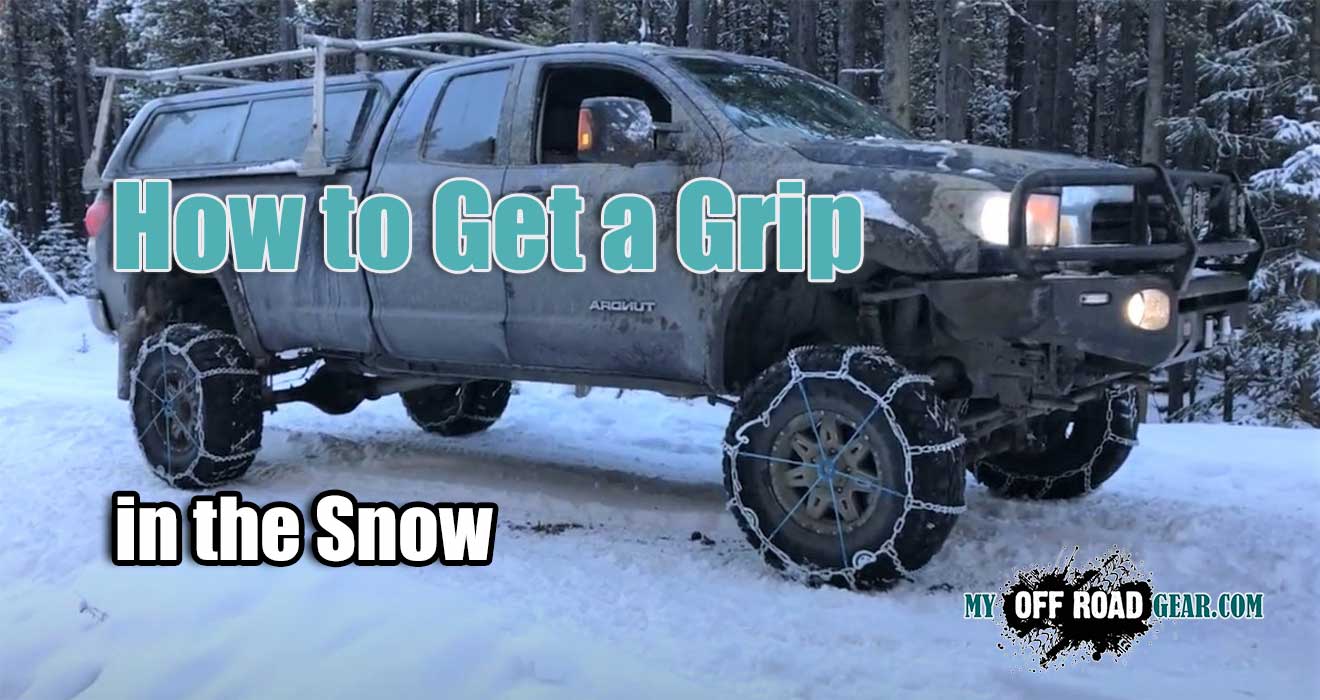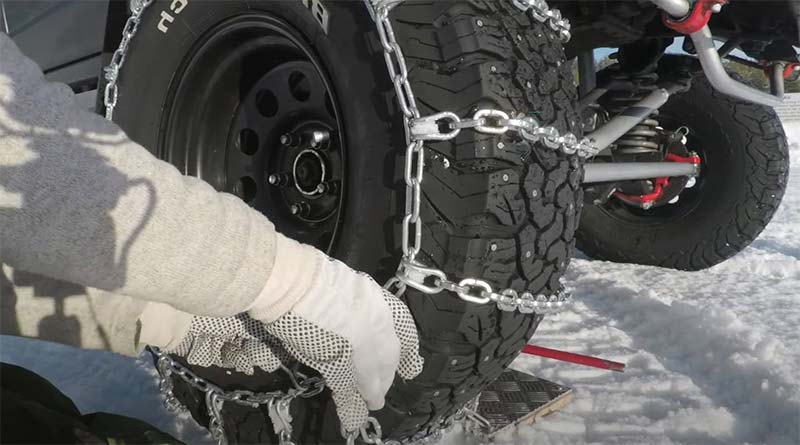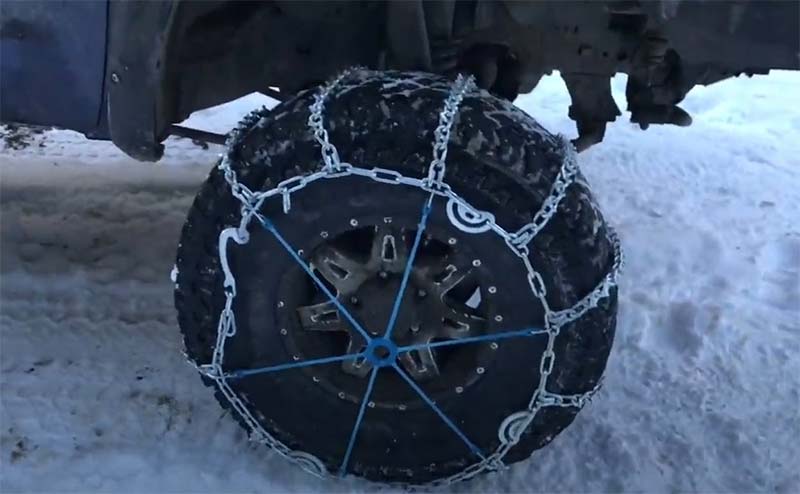Time needed: 20 minutes
Winter driving conditions can be challenging, especially when navigating snowy and icy roads. As a truck owner, it’s crucial to equip your vehicle with the right upgrades to ensure optimal grip and control. By taking proactive measures and investing in suitable accessories, you can enhance your truck’s performance and safely tackle snowy terrains. In this article, we will explore various strategies and truck upgrades to help you get a better grip in the snow.
Use Tire Chains with Easy: Helpful Hints!
Snow off-roading is great, chilling, fun, and coldly challenging. We’ve all seen the TV commercials for the winter sales of the fancy new 4WD bounding across snowfields, blasting fresh powder all over the camera! It looks like such fun! One problem with this scenario is that you have to watch out for tree stumps and rocks hidden by the deep, fresh powder. Blast across some meadows, and your tire could get shoved under your rig, bending the rims and flattening the tire. OUCH!
Be careful when the momentum factor carries you away. Should you go too fast, and the rig will slide off the trail. The ice under the snow will ensure that. You can be “clipping” down a trail in deep powder, come into a turn, try to negotiate the turn, and the rig continues straight. Here is where tire chains come in handy. This article is going to talk about what I feel are some of the most important pieces of equipment to help get you and your rig ready for the winter trail, tire chains in general.I usually use chains whenever I do any backcountry driving in the snow -4 tires, 4 chains. I’ve even written articles in the past on how to install tire chains, when to use them, and how to keep them from twisting up. But now I’ve found a much better way!
It literally takes half a minute to install a chain on a tire. I installed all four tire chains in minutes and didn’t have to move the tires at all to get the chains tight! I then drove right out of the predicament.
That’s right, the tires did not have to be rolled or the vehicle moved to install these chains. Although it is a good idea to roll down the road about 50 feet and make sure the chains are properly tensioned, in a tight spot like I had on the trail, they worked just fine without doing this.
It’s as simple as sliding the chain behind the tire, bringing the inner cable connector up to the top and making the connection for the inner link, then connecting the outer link, straightening the chain on the tire, pulling the tensioning chain through the locking mechanism, pulling tight, then hooking it to an appropriate link to keep the chain tensioner.
Tire Chains: Added Grip on Icy Surfaces
In extreme winter conditions, tire chains can provide additional grip on icy surfaces. Tire chains consist of metal links that wrap around the tires, increasing traction and preventing slipping. They are particularly useful when driving on steep inclines or encountering compacted ice and snow.
You can use chains for worn or non-aggressive tread tires too especially when driving through mud or loose rock. It is best to put them on the front axle so that you have steering, braking, and traction. Other suggestions for using chains are the following:
- Be cautious when spinning the tires. The fact is that the chains may catch on unseen stumps, rocks, as well as roots, and that will result in could breaking an axle or even a hub.
- Inspect the trail in deep snow – there may be hidden obstacles.
- Inspect chains before and after each ride. Watch out for worn links and stretched connectors.
- Apply some WD40 to the chains after each use. The chains shouldn’t rust.
- Be cautious when steering with the front end articulated. The chains should not contact vehicle components.
- Keep in mind, that tire chains will enable you to dig to the trail in deep snow and ice. Consider high-centering in those conditions. Sometimes, though very deep, it is best to use soft, high flotation tires to move across the top of deep drifts in lieu of chains. After that, you can air up to place the chains back on.
- Do not touch cold, icy chains with your bare hands. It is advised to use heavy-duty neoprene/rubber gloves. Leatherwork gloves of good quality will work too when you put chains on.
- Drive slowly and deliberate when the chains are on so that you gain proper traction and take control over the icy trail.
- Use higher RPMs in lower gears to keep the chains “churning.” Such an approach will ensure that ice breaks in hard-pack snow and the vehicle gains traction on the track.
No matter if you use your ride to get through wintry streets to get groceries or the kids to school or winch to a good ice fishing spot, you should be prepared for anything. Winter is the season of harsh trials and beautiful sceneries. You should always have the proper equipment on you and a good plan on how to use it. even if you have all the gear in the world, but you have no clue how to use it, little good will come out of it.
No matter what kind of rig you own, from stock showroom vehicles to the most radical off-road machines, you must always check it out before heading to the hills. You can prepare a checklist to be sure you have seasonal items that maybe wouldn’t make it into your kit at other times of the year. I built a shelf in my garage to hold the off-season items. That way, it goes in the vehicle, and when I’m done, it goes right back on the shelf in its place. I think it was Confucius who said: “A place for everything and everything in its place,” or maybe it was my drill sergeant.
Basic Rules for Using All Tire Chains
- Prepare chains prior to the primary use.
- Check the owner’s manual to see if the chains can be used on your type of vehicle.
- Make sure that the chains are correctly-sized for your tires.
- Follow directions for installing tire chains precisely. Apply the chains as tightly as you can to ensure the maximum chain life.
- Get off-highway somewhere to a safe place before installing, servicing, or removing tire chains.
- Don’t deflate tires to install tire chains. (Tires should be normal inflation.)
- Drive approximately 1/4 mile, then stop and retighten. Some additional links may be cut off or retained on the fastener arm. Apply the rubber adjusters after retightening. DO NOT USE ADJUSTERS ON “ALL CABLE-TYPE” CHAINS.
- Try not to exceed 30 miles per hour. Both accelerate and decelerate slowly. Do not allow the spinning or locking of wheels.
- If a cross-chain seems to fail, stop immediately. Continue with a repair or removal. NEVER DRIVE WITH A BROKEN CHAIN.
- Try not to hit curbs with tire chains on.
- Do not use tire chains while towing.
Snow Tires: The Key to Traction
Equipping your truck with snow tires is essential for maximizing traction on snowy and icy roads. Snow tires feature specialized tread patterns and rubber compounds designed to provide better grip in cold temperatures. They offer improved traction, braking performance, and handling, making them an excellent investment for winter driving.
All-Wheel Drive (AWD) or Four-Wheel Drive (4WD) Systems
Trucks equipped with all-wheel drive or four-wheel drive systems have an advantage when it comes to snowy conditions. These drivetrain configurations distribute power to all four wheels, improving traction and control. If your truck doesn’t already have AWD or 4WD, consider upgrading to a model that offers these capabilities for enhanced performance in the snow.
Upgrading to Studded Tires
Studded tires are another option to consider for extreme winter conditions. These tires feature metal studs embedded in the tread, providing excellent grip on icy surfaces. Studded tires are most effective in areas with prolonged icy conditions but may be subject to restrictions or regulations depending on your location.
Traction Control Systems
Many modern trucks are equipped with traction control systems. These systems utilize the truck’s braking and engine power to prevent wheel slippage and improve traction. Traction control helps ensure that power is appropriately distributed to the wheels with the most grip, allowing for better control and stability on snowy roads.
Driving a truck in snowy conditions requires special attention to traction and control. Snowy roads can be slippery and reduce your ability to grip the surface, increasing the risk of accidents. By implementing the following truck upgrades, you can optimize your vehicle’s performance and ensure a safer driving experience in the snow.
Anti-Lock Braking System (ABS)
An anti-lock braking system is a crucial safety feature for winter driving. ABS prevents the wheels from locking up during braking, allowing the driver to maintain steering control. This feature is particularly useful on slippery surfaces, as it helps prevent skidding and allows for more controlled braking.
Weight Distribution: Bed Load or Sandbags
Adding weight to the bed of your truck can improve traction by increasing tire grip. You can achieve this by loading the bed with sandbags or other heavy materials. The added weight over the rear axle provides more stability and traction, especially in rear-wheel-drive trucks.
Winter Windshield Wipers and Washer Fluid
Visibility is vital when driving in snowy conditions. Upgrading to winter windshield wipers with rugged blades and rubber designed for cold temperatures ensures clear visibility by effectively removing snow and ice from the windshield. Additionally, using winter-grade washer fluid helps prevent freezing on the windshield, allowing for continuous cleaning.
Conclusion
Upgrading your truck with the right accessories and implementing specific strategies can significantly enhance your grip and control on snowy roads. Snow tires, tire chains, AWD or 4WD systems, studded tires, traction control systems, ABS, weight distribution, winter windshield wipers, and washer fluid are all valuable upgrades and considerations for safer winter driving.
If you live in an area that gets plenty of snow, you may want to consider adding the Best Jeep Snow Plow to aid you in getting around with your new tires.
FAQs
Are snow tires necessary if I have all-wheel drive or four-wheel drive?
While all-wheel drive and four-wheel drive provide improved traction and control, snow tires are still highly recommended for optimal performance in snowy conditions. Snow tires offer specialized tread patterns and rubber compounds specifically designed to maximize grip on snow and ice.
Can I use tire chains on snow tires?
Yes, tire chains can be used on snow tires for added traction on icy surfaces. However, it’s important to consult the manufacturer’s recommendations and local regulations regarding the use of tire chains.
Do I need to add weight to my truck’s bed if it already has all-wheel drive?
While all-wheel drive provides improved traction, adding weight to the truck’s bed can further enhance stability and grip, especially in rear-wheel-drive trucks. It’s advisable to consult your vehicle’s manual or a trusted mechanic to determine the appropriate amount of weight to add.
Are studded tires legal everywhere?
The legality of studded tires varies depending on the region or state. Some areas restrict or prohibit the use of studded tires due to their potential to damage road surfaces. It’s important to check local regulations before considering studded tires as an option.





Add Comment